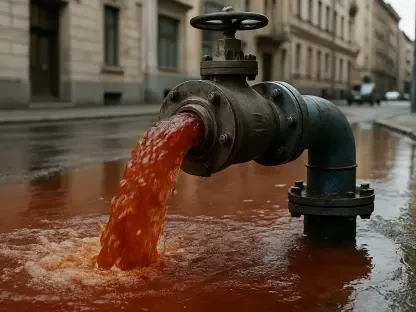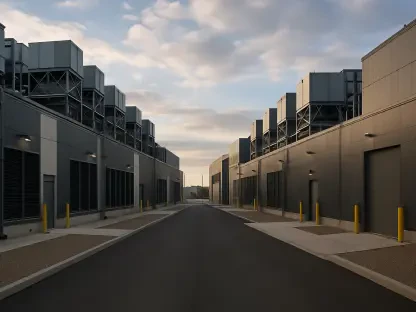The small city of Superior, Wisconsin, is grappling with a significant public health issue: the replacement of lead water pipes. Despite the availability of federal funding through the bipartisan infrastructure law, Superior faces unique challenges due to its privately-owned water utility. This unique status has sparked debate among city officials, legislators, and residents regarding the best path forward.
Federal Funding and Infrastructure Law
Federal Commitment to Clean Water
President Joe Biden has underscored the importance of clean water by announcing over $1 billion in federal funding aimed at eliminating lead pipes. These funds are part of a broader commitment under the bipartisan infrastructure law enacted in 2021, which allocated $15 billion to state loan programs intended to upgrade and modernize water systems across the country. This federal commitment aims to ensure that all Americans, regardless of where they live, have access to clean, lead-free drinking water.
The significance of this initiative cannot be overstated, as lead exposure, particularly in children, is known to cause severe developmental and health issues. Lead pipes, banned in 1986, still exist in many older water systems, posing a continuous health risk. Federal funds are aimed at removing these hazardous pipes as swiftly as possible, ideally giving priority to historically underserved or economically disadvantaged communities.
Allocation and Disbursement Constraints
A critical stipulation of the federal funding allocation is that approximately half of these funds must be provided as grants or forgivable loans to economically disadvantaged communities. This ensures that the financial burden on local governments and their residents is minimized while still achieving the overarching goal of replacing lead pipes. Superior qualifies for such financial aid based on its poverty levels and current economic conditions, making these grants and forgivable loans a potential lifeline for the community.
However, the distribution of these funds is contingent on certain conditions that complicate matters for Superior. State law currently limits the availability of these grants and forgivable loans to publicly-owned water systems. Given that Superior’s water utility, Superior Water Light & Power Company, is privately held, the city faces significant legal and bureaucratic hurdles in accessing this vital aid. This restriction has become a point of contention within the community and among local leaders who are grappling with how best to navigate these challenges.
Legal and Ownership Challenges
Private Ownership Barrier
Superior’s main hurdle in accessing federal aid is its privately-held water utility. The Superior Water Light & Power Company’s private ownership disqualifies it from loan forgiveness programs, which are currently available only to publicly-owned utilities. The state law that enforces this limitation is well-intentioned, designed to ensure that public funds are used for public resources. However, this policy inadvertently places Superior’s residents at a disadvantage despite their economic qualifications making them eligible for federal aid under other circumstances.
This private ownership status of the utility means that any financial burden of replacing the lead pipes would currently fall onto the residents and the privately-owned company. The private utility has limited means to absorb such sizable costs without significantly raising rates for consumers, many of whom are already financially strained. The detrimental impact this has on the economically disadvantaged population of Superior ultimately places public health at risk as pipe replacement plans stagnate due to funding constraints.
Legislative Proposals
In response to this situation, GOP legislators have introduced amendments to state law that would allow the Superior Water Light & Power Company to access loan forgiveness programs. This legislative proposal is seen by some as an essential step to unlocking significant federal resources that could alleviate the financial strain on residents and ensure the necessary infrastructure upgrades are undertaken without undue delay. The proposed amendments, if passed, could create a legal framework through which the funds can be utilized by a privately-owned utility, tailored specifically to address Superior’s unique predicament.
This proposal, however, has sparked divided opinions within the community and local government. There are concerns about the implications of altering state law for a single utility, which some argue could set precedents for private companies seeking public funds. Questions about fairness, accountability, and the long-term impact on public resource management continue to fuel debates among local officials and the broader community.
Economic Disparities and Community Impact
Superior’s Economic Profile
The economic landscape of Superior showcases substantial financial challenges for its residents. The community is characterized by higher unemployment rates and lower household incomes compared to state averages. These economic disparities have rendered the community particularly vulnerable, making federal aid crucial for both immediate and long-term public health and infrastructure improvements.
Economic hardship in Superior means that many residents are already facing difficulties in affording even basic necessities, let alone additional financial contributions to support water system upgrades. The lack of adequate financial support places an undue burden on the community, exacerbating existing inequalities and perpetuating a cycle of economic difficulty and infrastructure decay.
Rising Water Costs
Compounding the issues of economic hardship, Superior Water Light & Power has implemented an approximate 11% increase in water rates. This rate hike, justified by the utility as necessary to maintain and upgrade water systems, further amplifies the financial strain on the city’s economically disadvantaged population. While the need for infrastructure improvements is clear, the immediate impact of rising water rates on household budgets cannot be overlooked.
For many residents, the increased costs translate to difficult choices between essential needs such as food, healthcare, and other utilities. This has led to mounting concern and frustration within the community, where the implications of increased water rates are seen as disproportionately affecting those least able to afford them. The rate increase has further fueled the debate on the best path to resolving the lead pipe replacement issue, considering the long-term affordability and sustainability of the water utility.
Public and Private Debate
Support for Legislative Change
Among the solutions proposed, some residents and local leaders are in favor of the legislative amendments that would permit the Superior Water Light & Power Company to access the much-needed federal funds. This path is viewed as a fair and direct means to unlocking financial relief and ensuring that infrastructure improvements can proceed without further delays. Supporters argue that this legislative change would provide the necessary financial mechanisms to engage in comprehensive and effective lead pipe replacements while stemming the immediate economic impact on residents.
From this perspective, leveraging existing state infrastructure programs but adapting them to Superior’s unique situation emerges as a practical and expedient approach. Supporters emphasize the urgency of addressing the public health risks posed by lead pipes and see the legislative amendment as the most feasible solution to navigate between the constraints of state laws and the need for inclusive funding mechanisms.
Advocacy for Municipal Control
Alternatively, other local officials and some council members propose that the city should purchase the utility instead of pursuing legislative changes that may ultimately serve the interests of a private company more than the public. Advocates for municipal control argue that public ownership would ensure that all federal and state funding opportunities are available to the utility, thereby facilitating better management of resources and potentially reducing long-term water rates for residents.
Public ownership, they suggest, aligns the utility’s objectives directly with the public interest, providing greater transparency, accountability, and control over water quality and pricing. This proposal, while presenting a larger initial fiscal challenge, is seen as a long-term investment in the community, potentially yielding more substantial benefits compared to merely amending legislation for immediate gain. The debate centers on evaluating immediate financial relief versus the broader strategic benefits of municipal ownership and its implications for sustainable water management.
Financial Implications and Estimates
Cost of Replacement Project
The comprehensive cost of replacing both private and utility-owned lead lines in Superior is estimated at $44 million—an amount that reflects the extensive work needed to overhaul the city’s aging water infrastructure. The daunting financial aspect of such a large-scale public health initiative underscores the importance of federal loan forgiveness programs, which could significantly reduce this financial burden on the community if Superior could access them.
The substantial initial investment required for lead pipe replacement presents both an immediate and long-term challenge for the city. For a community already grappling with high unemployment and low household incomes, such an expense could push the ongoing economic disparity further, making it imperative to secure external funding assistance where available. Federal loan forgiveness stands as a potentially transformative solution to mitigate these financial pressures and expedite the critical infrastructure project.
Discrepancies in Replacement Costs
Interestingly, there are marked discrepancies between the cost estimates provided by Superior Water Light & Power and those from the Department of Natural Resources. The utility estimates that replacing private lead lines would cost an average of $10,000 per household, totaling substantial figures for the estimated 700 private lines requiring replacement. These high estimates present a further financial complication for both the utility and its ratepayers, making the pursuit of federal aid even more critical.
In contrast, the Department of Natural Resources (DNR) suggests that average replacement costs could be closer to $5,000 per household, a significantly lower figure that calls into question the utility’s higher estimates. This discrepancy raises important considerations about the accuracy of cost assessments, the potential for inflated budget projections, and the real financial needs of the project. Addressing these differences is crucial for transparent financial planning and ensuring that federal and state resources are adequately allocated for maximum impact.
Strategic Decision Points and Future Prospects
State Law Amendments vs. Acquisition
Faced with these complex financial and legislative challenges, Superior’s Mayor Jim Paine and some council members have suggested that the city should borrow money to purchase the utility. This approach is perceived by advocates as a strategic move to bring the utility into the public domain, potentially reducing long-term water costs for residents once the debt is repaid. The proposal emphasizes the necessity for the city to exercise control over its water resources, ensuring that public health priorities and financial sustainability can be balanced more effectively.
However, this proposal is not without scrutiny. Concerns have been raised regarding the city’s capacity to run the utility efficiently and the financial viability of such an endeavor. Critics question whether the city government has the necessary experience, infrastructure, and financial stability to manage the utility without exacerbating existing economic pressures. The debate highlights a critical decision point for Superior’s leaders as they weigh the benefits of public ownership against the immediate financial and operational challenges it presents.
Urgency of Action
Superior, Wisconsin, is currently dealing with a significant public health concern: replacing its lead water pipes. The urgency to address this issue comes from the dangers posed by lead-contaminated water, which can have severe health impacts, particularly on children. The federal government has provided funding for such initiatives through the bipartisan infrastructure law. However, despite the availability of these funds, Superior is encountering unique challenges that hinder the pipe replacement process.
A key hurdle is that Superior’s water utility is privately owned rather than being managed by the city. This private ownership status has given rise to debates among city officials, state legislators, and local residents. It’s unclear how to best leverage the federal funds due to legal and logistical complications tied to private ownership. This has led to concerns about how swiftly and effectively the city can address the replacement of the lead pipes.
Some city officials advocate for public ownership of the water utility to streamline the funding and replacement process, while others worry about the financial and bureaucratic hurdles of such a move. Residents remain divided, with many eager for prompt solutions but uncertain about the most efficient path forward. This issue requires balancing public health concerns, financial feasibility, and legal considerations, making the road to resolution complex.









